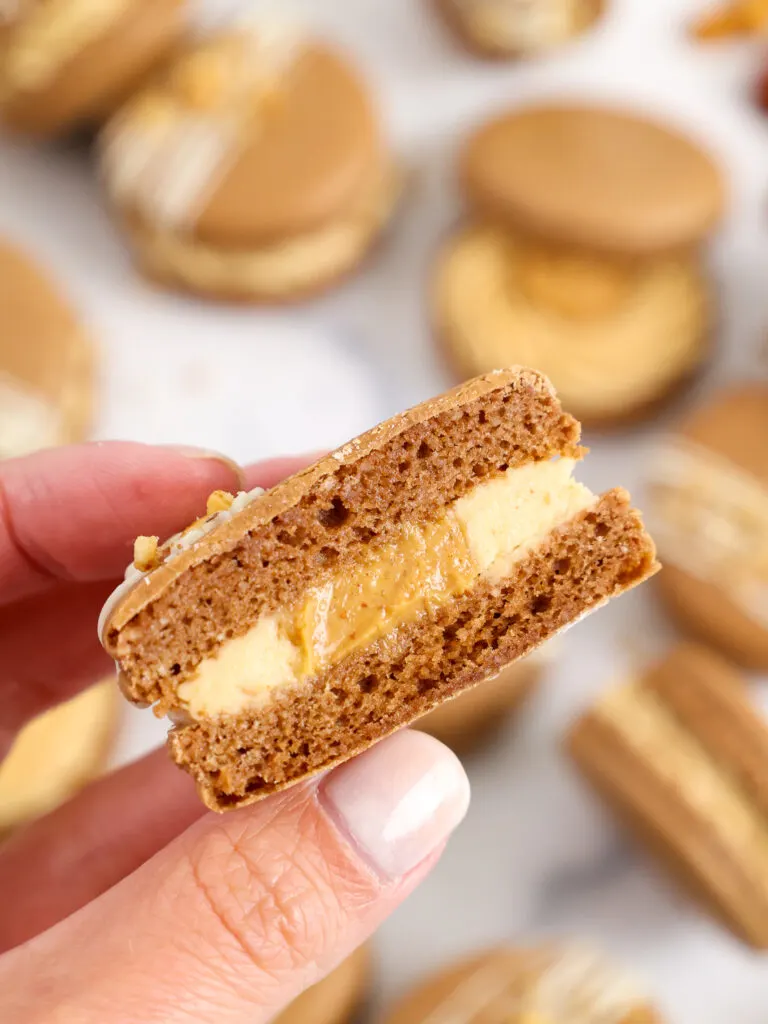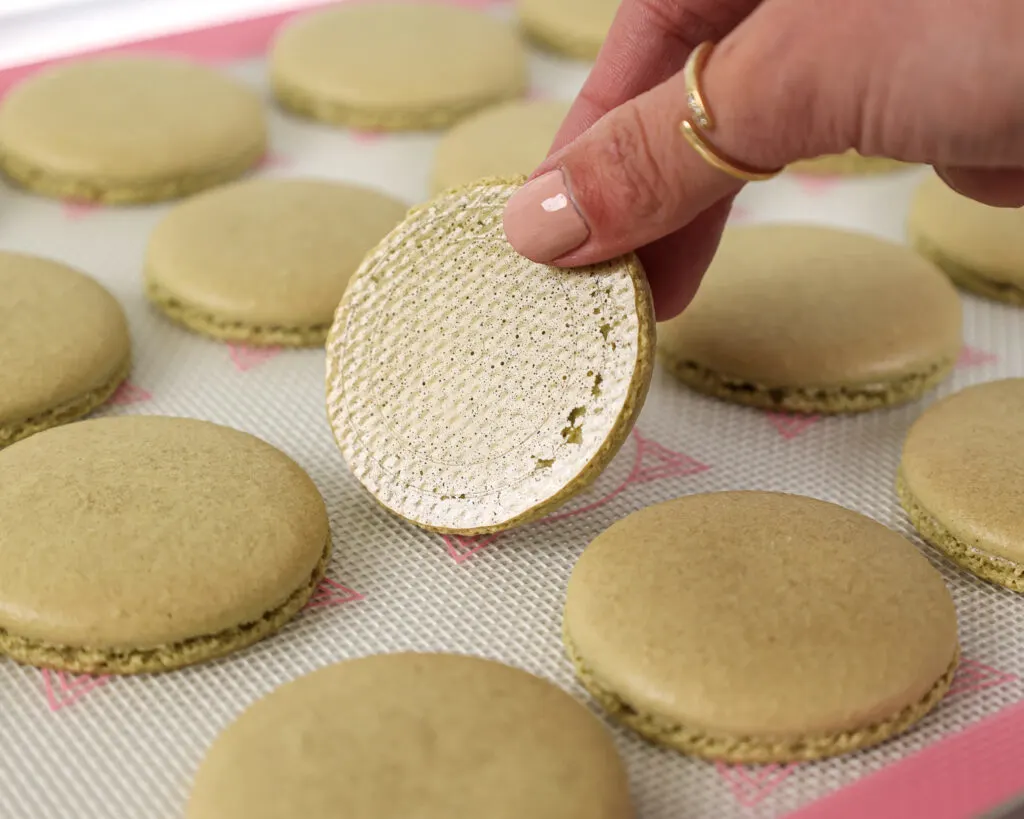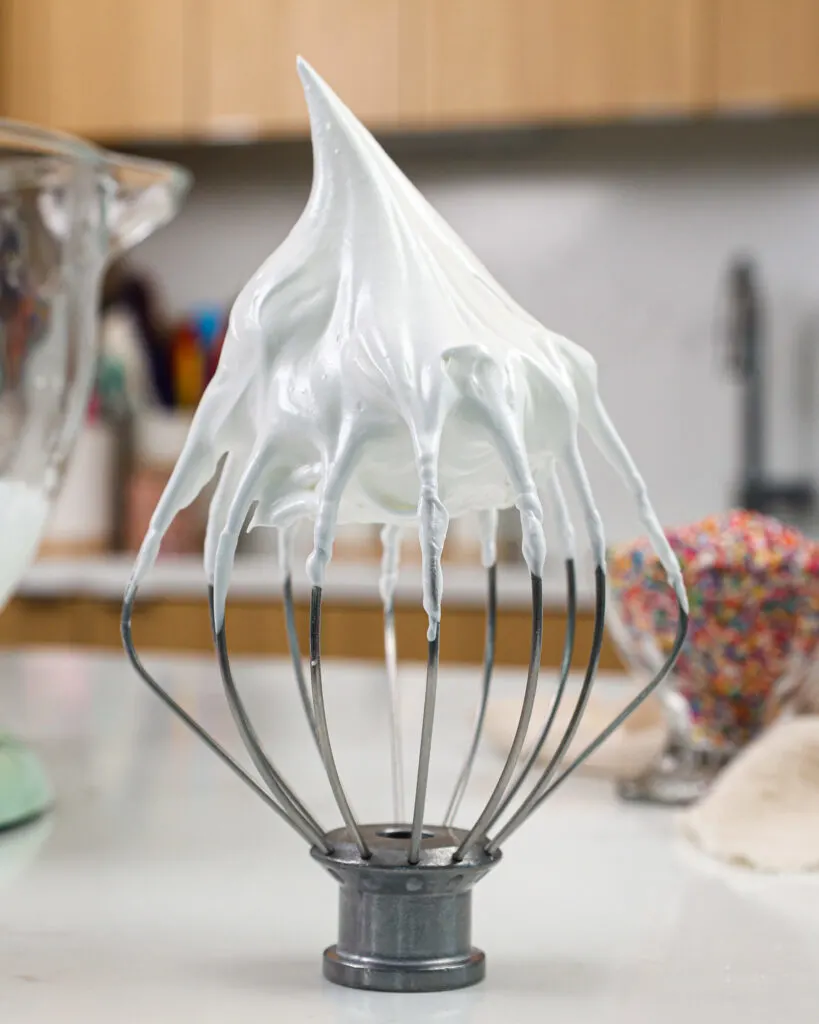The deeper I got into my macaron journey, the happier I was with the outward appearance of my shells. However, just because they look good on the outside, it doesn’t always mean they’re good on the inside. To my dismay, I realized I was making hollow macarons.
It was so disheartening to put all that energy into the macaron shells, just to bite into them and see a giant gap between the center of the cookie and the top of the shell.

While I touch on hollow macaron shells briefly in my macaron troubleshooting guide, this topic needs its own post!
There are quite a few things that can cause hollow macarons. Let’s walk through each of them together and chat about how they can be avoided in the future.
Why Are Hollow Macaron Shells Bad?
Before we talk about hollow shells, let’s talk about why (and when) hollow macaron shells are a problem.
A lot of the time macaron shells that have just been baked DO have a small gap between the center and top of the shell. This is totally normal and honestly not a problem.
The inside of the shells usually fills in once they macarons are filled and have a chance to sit in the fridge overnight.
The only time hollow shells are a problem is when it ruins the integrity of the shell.
If the gap inside causes the top of the shells to be super fragile and break easily (like when you try to fill and sandwich the shells together), then you have a problem.
Otherwise, if your macarons have a small gap but they’re chewy, sturdy enough to bit into, and have nice feet, I wouldn’t worry about it!

Why Are My Macarons Hollow?
The most common causes of hollow macaron shells are:
- Not letting the shells / macarons rest and mature
- Underbaked shells
- Macaron batter that isn’t mixed the right amount
- Over or under-mixed meringue
Let’s talk about each of these in a bit more depth!
Hollow Macarons Cause #1: The Macaron Shells Haven’t Matured
Like I mentioned above, it’s extremely uncommon for macaron shells to come out of the oven with completely full shells.
And to be honest, they don’t need to be full coming out of the oven. Once you’ve filled the macarons, the moisture from the filling seeps into the shells.
This is what gives macarons that deliciously chewy texture. It also helps fill that little air gap!
So, if your baked macaron shells are hollow, give them a little time to mature in the fridge. Filled macarons should sit in the fridge overnight before they’re enjoyed.
For me, this fills in those little gaps like 97% of the time!

Hollow Macarons Cause #2: Underbaked Shells
I went through a phase when I got a new oven where underbaked shells were the bane of my existence.
When you think about a time-lapse of macaron shells baking, they puff up and then settle down a little bit at the end.
If the shells aren’t baked for long enough, the center of the shells will collapse inside as they cool. It’s the same concept as an underbaked cake layer that sinks in the center.
It’s just harder to see because of the top of the shell.
A tell-tale sign that macaron shells are underbaked is that they don’t peel cleanly off the mat once they’ve cooled.
To avoid underbaked shells in the future, you can either increase the temperature of the oven (I recommend an increase of 5F) or let the shells bake slightly longer.

Hollow Macarons Cause #3: The Macaron Batter Isn’t Mixed Properly
In my experience, this is also a common culprit of hollow shells. If the batter is under- or over-mixed, it means that there isn’t the right amount of air in the batter.
If the batter is under-mixed, the top of the shells won’t be smooth and will look kind of pointed after you pipe them.
As the macaron shells bake, the extra air in the batter rises but gets trapped underneath the skin that’s formed on top of the macaron shell.
The best way to avoid this is to gently spread the macaron batter along the sides of your bowl once the dry ingredients have been incorporated. This gently and uniformly deflates that meringue in the batter.
It’s also helpful to regularly check the consistency of the batter as you fold it. As you scoop and lift the batter with your rubber spatula, look at the way it falls.
You’re looking for a thick ribbon of batter running in a continuous stream. If the batter seems to break as it falls or falls in clumps, it needs to be mixed a bit more.

If the batter is over-mixed, it’s not as easy to see immediately.
The batter might look good flowing off the spatula, but if you’ve deflated the meringue too much by over-mixing, it can prevent the center of the macaron shells from baking up to fill the entire shell.
If everything else about the shells seems great (nice feet, peel off the mat cleanly, sturdy tops) but they’re still hollow, try mixing the batter slightly less next time.
A few less folds might be just what your macaron shells need.
Hollow Macarons Cause #4: Over or Under-Mixed Meringue
The final cause of hollow macarons is over or under-mixed meringue.
A lot of the time you can adjust the amount you mix the batter to make up this. However, if the meringue is severely over- or under-mixed, it can cause hollow shells.
Whether the meringue is over- or under-whipped, the structure of the meringue is compromised. The structure of the meringue is what gives macaron batter its unique consistency, so this can be a big problem.
The best way to avoid this is to mix the meringue on a medium to medium-high speed. Meringue that’s whipped up gradually is more stable, and this makes the macaronage process more forgiving.
I recommend checking in on the meringue a few times as it mixes. There’s no downside to checking the consistency of the meringue, so you can check it as frequently as you want. In my opinion, this is the best way to make sure the meringue is mixed the perfect amount.
Mix until the meringue has stiff peaks that stick straight up on their own. I almost always make French meringue, and this is the consistency I look for when I check it.

Let Me Know What You Think!
I hope that this post helps you avoid hollow macarons in the future! If you have any additional questions, please share them in the comments section below 🙂

Marlies
Saturday 6th of April 2024
Hi,
My macarons are full when I break one open immediately after baking but when they cool down they are hollow. I tried baking longer but that didn’t work. I just got a hard cripsy hollow macaron then.
I whip my meringue on speed 4 and with a large batch also on 6 after soft peak stage.
Do you have any suggestions?
Chelsweets
Sunday 7th of April 2024
Hi Marlies,
My first suggestion would be to bake them longer, but you've already tried that! Once you fill the macarons and let them mature in the fridge, are the shells still hollow?
Sometimes shells aren't perfectly full coming out of the oven/once they've cooled, but they puff back up once they've matured. I know it's annoying/not what you probably want to hear, but as long as your shells are full once they've matured, I wouldn't worry about them being a little bit hollow once they've cooled down. Hope that helps, happy baking!
Nadia
Thursday 24th of August 2023
Hello, I bake macarons for about 19 minutes at 300F. I keep them in the middle rack. Most of the times, they turn out little hard from outside but also underbaked. Do you think I should decrease the temperature and bake for longer ?
Chelsweets
Friday 25th of August 2023
Hi Nadia,
When you say underbaked on the inside, do you mean they're hollow? What is the texture like once you fill them and let them sit in the fridge overnight? Usually they soften and fluff up once they mature in the fridge!